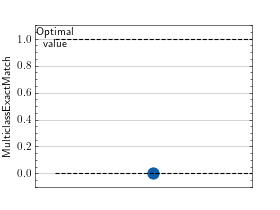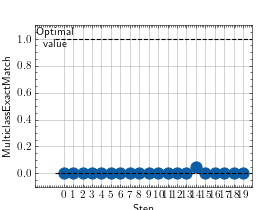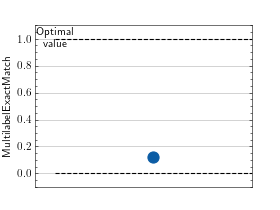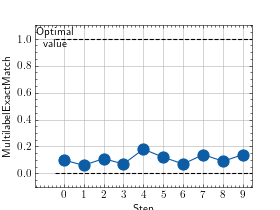Exact Match¶
Module Interface¶
- class torchmetrics.ExactMatch(**kwargs)[source]¶
Compute Exact match (also known as subset accuracy).
Exact Match is a stricter version of accuracy where all labels have to match exactly for the sample to be correctly classified.
This module is a simple wrapper to get the task specific versions of this metric, which is done by setting the
taskargument to either'multiclass'or'multilabel'. See the documentation ofMulticlassExactMatchandMultilabelExactMatchfor the specific details of each argument influence and examples.- Legacy Example:
>>> from torch import tensor >>> target = tensor([[[0, 1], [2, 1], [0, 2]], [[1, 1], [2, 0], [1, 2]]]) >>> preds = tensor([[[0, 1], [2, 1], [0, 2]], [[2, 2], [2, 1], [1, 0]]]) >>> metric = ExactMatch(task="multiclass", num_classes=3, multidim_average='global') >>> metric(preds, target) tensor(0.5000)
>>> target = tensor([[[0, 1], [2, 1], [0, 2]], [[1, 1], [2, 0], [1, 2]]]) >>> preds = tensor([[[0, 1], [2, 1], [0, 2]], [[2, 2], [2, 1], [1, 0]]]) >>> metric = ExactMatch(task="multiclass", num_classes=3, multidim_average='samplewise') >>> metric(preds, target) tensor([1., 0.])
MulticlassExactMatch¶
- class torchmetrics.classification.MulticlassExactMatch(num_classes, multidim_average='global', ignore_index=None, validate_args=True, **kwargs)[source]¶
Compute Exact match (also known as subset accuracy) for multiclass tasks.
Exact Match is a stricter version of accuracy where all labels have to match exactly for the sample to be correctly classified.
As input to
forwardandupdatethe metric accepts the following input:preds(Tensor): An int tensor of shape(N, ...)or float tensor of shape(N, C, ..). If preds is a floating point we applytorch.argmaxalong theCdimension to automatically convert probabilities/logits into an int tensor.target(Tensor): An int tensor of shape(N, ...).
As output to
forwardandcomputethe metric returns the following output:mcem(Tensor): A tensor whose returned shape depends on themultidim_averageargument:If
multidim_averageis set toglobalthe output will be a scalar tensorIf
multidim_averageis set tosamplewisethe output will be a tensor of shape(N,)
If
multidim_averageis set tosamplewisewe expect at least one additional dimension...to be present, which the reduction will then be applied over instead of the sample dimensionN.- Parameters:
num_classes¶ (
int) – Integer specifying the number of labelsmultidim_average¶ (
Literal['global','samplewise']) –Defines how additionally dimensions
...should be handled. Should be one of the following:global: Additional dimensions are flatted along the batch dimensionsamplewise: Statistic will be calculated independently for each sample on theNaxis. The statistics in this case are calculated over the additional dimensions.
ignore_index¶ (
Optional[int]) – Specifies a target value that is ignored and does not contribute to the metric calculationvalidate_args¶ (
bool) – bool indicating if input arguments and tensors should be validated for correctness. Set toFalsefor faster computations.
- Example (multidim tensors):
>>> from torch import tensor >>> from torchmetrics.classification import MulticlassExactMatch >>> target = tensor([[[0, 1], [2, 1], [0, 2]], [[1, 1], [2, 0], [1, 2]]]) >>> preds = tensor([[[0, 1], [2, 1], [0, 2]], [[2, 2], [2, 1], [1, 0]]]) >>> metric = MulticlassExactMatch(num_classes=3, multidim_average='global') >>> metric(preds, target) tensor(0.5000)
- Example (multidim tensors):
>>> from torchmetrics.classification import MulticlassExactMatch >>> target = tensor([[[0, 1], [2, 1], [0, 2]], [[1, 1], [2, 0], [1, 2]]]) >>> preds = tensor([[[0, 1], [2, 1], [0, 2]], [[2, 2], [2, 1], [1, 0]]]) >>> metric = MulticlassExactMatch(num_classes=3, multidim_average='samplewise') >>> metric(preds, target) tensor([1., 0.])
- plot(val=None, ax=None)[source]¶
Plot a single or multiple values from the metric.
- Parameters:
val¶ (
Union[Tensor,Sequence[Tensor],None]) – Either a single result from calling metric.forward or metric.compute or a list of these results. If no value is provided, will automatically call metric.compute and plot that result.ax¶ (
Optional[Axes]) – An matplotlib axis object. If provided will add plot to that axis
- Return type:
- Returns:
Figure object and Axes object
- Raises:
ModuleNotFoundError – If matplotlib is not installed
>>> # Example plotting a single value per class >>> from torch import randint >>> from torchmetrics.classification import MulticlassExactMatch >>> metric = MulticlassExactMatch(num_classes=3) >>> metric.update(randint(3, (20,5)), randint(3, (20,5))) >>> fig_, ax_ = metric.plot()

>>> from torch import randint >>> # Example plotting a multiple values per class >>> from torchmetrics.classification import MulticlassExactMatch >>> metric = MulticlassExactMatch(num_classes=3) >>> values = [] >>> for _ in range(20): ... values.append(metric(randint(3, (20,5)), randint(3, (20,5)))) >>> fig_, ax_ = metric.plot(values)

MultilabelExactMatch¶
- class torchmetrics.classification.MultilabelExactMatch(num_labels, threshold=0.5, multidim_average='global', ignore_index=None, validate_args=True, **kwargs)[source]¶
Compute Exact match (also known as subset accuracy) for multilabel tasks.
Exact Match is a stricter version of accuracy where all labels have to match exactly for the sample to be correctly classified.
As input to
forwardandupdatethe metric accepts the following input:preds(Tensor): An int tensor or float tensor of shape(N, C, ..). If preds is a floating point tensor with values outside [0,1] range we consider the input to be logits and will auto apply sigmoid per element. Additionally, we convert to int tensor with thresholding using the value inthreshold.target(Tensor): An int tensor of shape(N, C, ...).
As output to
forwardandcomputethe metric returns the following output:mlem(Tensor): A tensor whose returned shape depends on themultidim_averageargument:If
multidim_averageis set toglobalthe output will be a scalar tensorIf
multidim_averageis set tosamplewisethe output will be a tensor of shape(N,)
If
multidim_averageis set tosamplewisewe expect at least one additional dimension...to be present, which the reduction will then be applied over instead of the sample dimensionN.- Parameters:
threshold¶ (
float) – Threshold for transforming probability to binary (0,1) predictionsmultidim_average¶ (
Literal['global','samplewise']) –Defines how additionally dimensions
...should be handled. Should be one of the following:global: Additional dimensions are flatted along the batch dimensionsamplewise: Statistic will be calculated independently for each sample on theNaxis. The statistics in this case are calculated over the additional dimensions.
ignore_index¶ (
Optional[int]) – Specifies a target value that is ignored and does not contribute to the metric calculationvalidate_args¶ (
bool) – bool indicating if input arguments and tensors should be validated for correctness. Set toFalsefor faster computations.
- Example (preds is int tensor):
>>> from torch import tensor >>> from torchmetrics.classification import MultilabelExactMatch >>> target = tensor([[0, 1, 0], [1, 0, 1]]) >>> preds = tensor([[0, 0, 1], [1, 0, 1]]) >>> metric = MultilabelExactMatch(num_labels=3) >>> metric(preds, target) tensor(0.5000)
- Example (preds is float tensor):
>>> from torchmetrics.classification import MultilabelExactMatch >>> target = tensor([[0, 1, 0], [1, 0, 1]]) >>> preds = tensor([[0.11, 0.22, 0.84], [0.73, 0.33, 0.92]]) >>> metric = MultilabelExactMatch(num_labels=3) >>> metric(preds, target) tensor(0.5000)
- Example (multidim tensors):
>>> from torchmetrics.classification import MultilabelExactMatch >>> target = tensor([[[0, 1], [1, 0], [0, 1]], [[1, 1], [0, 0], [1, 0]]]) >>> preds = tensor([[[0.59, 0.91], [0.91, 0.99], [0.63, 0.04]], ... [[0.38, 0.04], [0.86, 0.780], [0.45, 0.37]]]) >>> metric = MultilabelExactMatch(num_labels=3, multidim_average='samplewise') >>> metric(preds, target) tensor([0., 0.])
- plot(val=None, ax=None)[source]¶
Plot a single or multiple values from the metric.
- Parameters:
val¶ (
Union[Tensor,Sequence[Tensor],None]) – Either a single result from calling metric.forward or metric.compute or a list of these results. If no value is provided, will automatically call metric.compute and plot that result.ax¶ (
Optional[Axes]) – An matplotlib axis object. If provided will add plot to that axis
- Return type:
- Returns:
Figure and Axes object
- Raises:
ModuleNotFoundError – If matplotlib is not installed
>>> # Example plotting a single value >>> from torch import rand, randint >>> from torchmetrics.classification import MultilabelExactMatch >>> metric = MultilabelExactMatch(num_labels=3) >>> metric.update(randint(2, (20, 3, 5)), randint(2, (20, 3, 5))) >>> fig_, ax_ = metric.plot()

>>> # Example plotting multiple values >>> from torch import rand, randint >>> from torchmetrics.classification import MultilabelExactMatch >>> metric = MultilabelExactMatch(num_labels=3) >>> values = [ ] >>> for _ in range(10): ... values.append(metric(randint(2, (20, 3, 5)), randint(2, (20, 3, 5)))) >>> fig_, ax_ = metric.plot(values)

Functional Interface¶
exact_match¶
- torchmetrics.functional.classification.exact_match(preds, target, task, num_classes=None, num_labels=None, threshold=0.5, multidim_average='global', ignore_index=None, validate_args=True)[source]¶
Compute Exact match (also known as subset accuracy).
Exact Match is a stricter version of accuracy where all classes/labels have to match exactly for the sample to be correctly classified.
This function is a simple wrapper to get the task specific versions of this metric, which is done by setting the
taskargument to either'multiclass'or'multilabel'. See the documentation ofmulticlass_exact_match()andmultilabel_exact_match()for the specific details of each argument influence and examples.- Return type:
- Legacy Example:
>>> from torch import tensor >>> target = tensor([[[0, 1], [2, 1], [0, 2]], [[1, 1], [2, 0], [1, 2]]]) >>> preds = tensor([[[0, 1], [2, 1], [0, 2]], [[2, 2], [2, 1], [1, 0]]]) >>> exact_match(preds, target, task="multiclass", num_classes=3, multidim_average='global') tensor(0.5000)
>>> target = tensor([[[0, 1], [2, 1], [0, 2]], [[1, 1], [2, 0], [1, 2]]]) >>> preds = tensor([[[0, 1], [2, 1], [0, 2]], [[2, 2], [2, 1], [1, 0]]]) >>> exact_match(preds, target, task="multiclass", num_classes=3, multidim_average='samplewise') tensor([1., 0.])
multiclass_exact_match¶
- torchmetrics.functional.classification.multiclass_exact_match(preds, target, num_classes, multidim_average='global', ignore_index=None, validate_args=True)[source]¶
Compute Exact match (also known as subset accuracy) for multiclass tasks.
Exact Match is a stricter version of accuracy where all labels have to match exactly for the sample to be correctly classified.
Accepts the following input tensors:
preds:(N, ...)(int tensor) or(N, C, ..)(float tensor). If preds is a floating point we applytorch.argmaxalong theCdimension to automatically convert probabilities/logits into an int tensor.target(int tensor):(N, ...)
- Parameters:
num_classes¶ (
int) – Integer specifying the number of labelsmultidim_average¶ (
Literal['global','samplewise']) –Defines how additionally dimensions
...should be handled. Should be one of the following:global: Additional dimensions are flatted along the batch dimensionsamplewise: Statistic will be calculated independently for each sample on theNaxis. The statistics in this case are calculated over the additional dimensions.
ignore_index¶ (
Optional[int]) – Specifies a target value that is ignored and does not contribute to the metric calculationvalidate_args¶ (
bool) – bool indicating if input arguments and tensors should be validated for correctness. Set toFalsefor faster computations.
- Returns:
If
multidim_averageis set toglobalthe output will be a scalar tensorIf
multidim_averageis set tosamplewisethe output will be a tensor of shape(N,)
- Return type:
The returned shape depends on the
multidim_averageargument
- Example (multidim tensors):
>>> from torch import tensor >>> from torchmetrics.functional.classification import multiclass_exact_match >>> target = tensor([[[0, 1], [2, 1], [0, 2]], [[1, 1], [2, 0], [1, 2]]]) >>> preds = tensor([[[0, 1], [2, 1], [0, 2]], [[2, 2], [2, 1], [1, 0]]]) >>> multiclass_exact_match(preds, target, num_classes=3, multidim_average='global') tensor(0.5000)
- Example (multidim tensors):
>>> from torchmetrics.functional.classification import multiclass_exact_match >>> target = tensor([[[0, 1], [2, 1], [0, 2]], [[1, 1], [2, 0], [1, 2]]]) >>> preds = tensor([[[0, 1], [2, 1], [0, 2]], [[2, 2], [2, 1], [1, 0]]]) >>> multiclass_exact_match(preds, target, num_classes=3, multidim_average='samplewise') tensor([1., 0.])
multilabel_exact_match¶
- torchmetrics.functional.classification.multilabel_exact_match(preds, target, num_labels, threshold=0.5, multidim_average='global', ignore_index=None, validate_args=True)[source]¶
Compute Exact match (also known as subset accuracy) for multilabel tasks.
Exact Match is a stricter version of accuracy where all labels have to match exactly for the sample to be correctly classified.
Accepts the following input tensors:
preds(int or float tensor):(N, C, ...). If preds is a floating point tensor with values outside [0,1] range we consider the input to be logits and will auto apply sigmoid per element. Additionally, we convert to int tensor with thresholding using the value inthreshold.target(int tensor):(N, C, ...)
- Parameters:
threshold¶ (
float) – Threshold for transforming probability to binary (0,1) predictionsmultidim_average¶ (
Literal['global','samplewise']) –Defines how additionally dimensions
...should be handled. Should be one of the following:global: Additional dimensions are flatted along the batch dimensionsamplewise: Statistic will be calculated independently for each sample on theNaxis. The statistics in this case are calculated over the additional dimensions.
ignore_index¶ (
Optional[int]) – Specifies a target value that is ignored and does not contribute to the metric calculationvalidate_args¶ (
bool) – bool indicating if input arguments and tensors should be validated for correctness. Set toFalsefor faster computations.
- Returns:
If
multidim_averageis set toglobalthe output will be a scalar tensorIf
multidim_averageis set tosamplewisethe output will be a tensor of shape(N,)
- Return type:
The returned shape depends on the
multidim_averageargument
- Example (preds is int tensor):
>>> from torch import tensor >>> from torchmetrics.functional.classification import multilabel_exact_match >>> target = tensor([[0, 1, 0], [1, 0, 1]]) >>> preds = tensor([[0, 0, 1], [1, 0, 1]]) >>> multilabel_exact_match(preds, target, num_labels=3) tensor(0.5000)
- Example (preds is float tensor):
>>> from torchmetrics.functional.classification import multilabel_exact_match >>> target = tensor([[0, 1, 0], [1, 0, 1]]) >>> preds = tensor([[0.11, 0.22, 0.84], [0.73, 0.33, 0.92]]) >>> multilabel_exact_match(preds, target, num_labels=3) tensor(0.5000)
- Example (multidim tensors):
>>> from torchmetrics.functional.classification import multilabel_exact_match >>> target = tensor([[[0, 1], [1, 0], [0, 1]], [[1, 1], [0, 0], [1, 0]]]) >>> preds = tensor([[[0.59, 0.91], [0.91, 0.99], [0.63, 0.04]], ... [[0.38, 0.04], [0.86, 0.780], [0.45, 0.37]]]) >>> multilabel_exact_match(preds, target, num_labels=3, multidim_average='samplewise') tensor([0., 0.])
